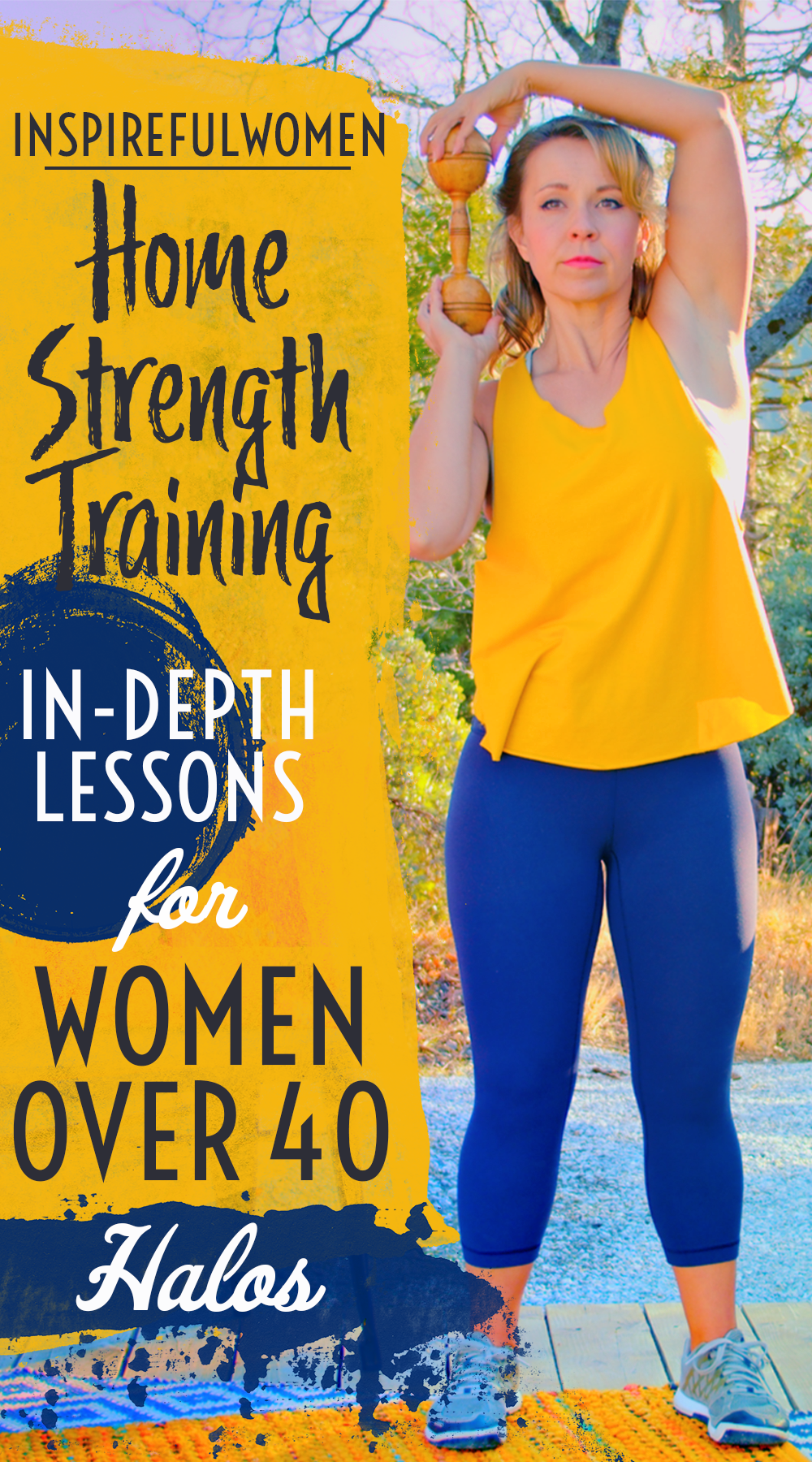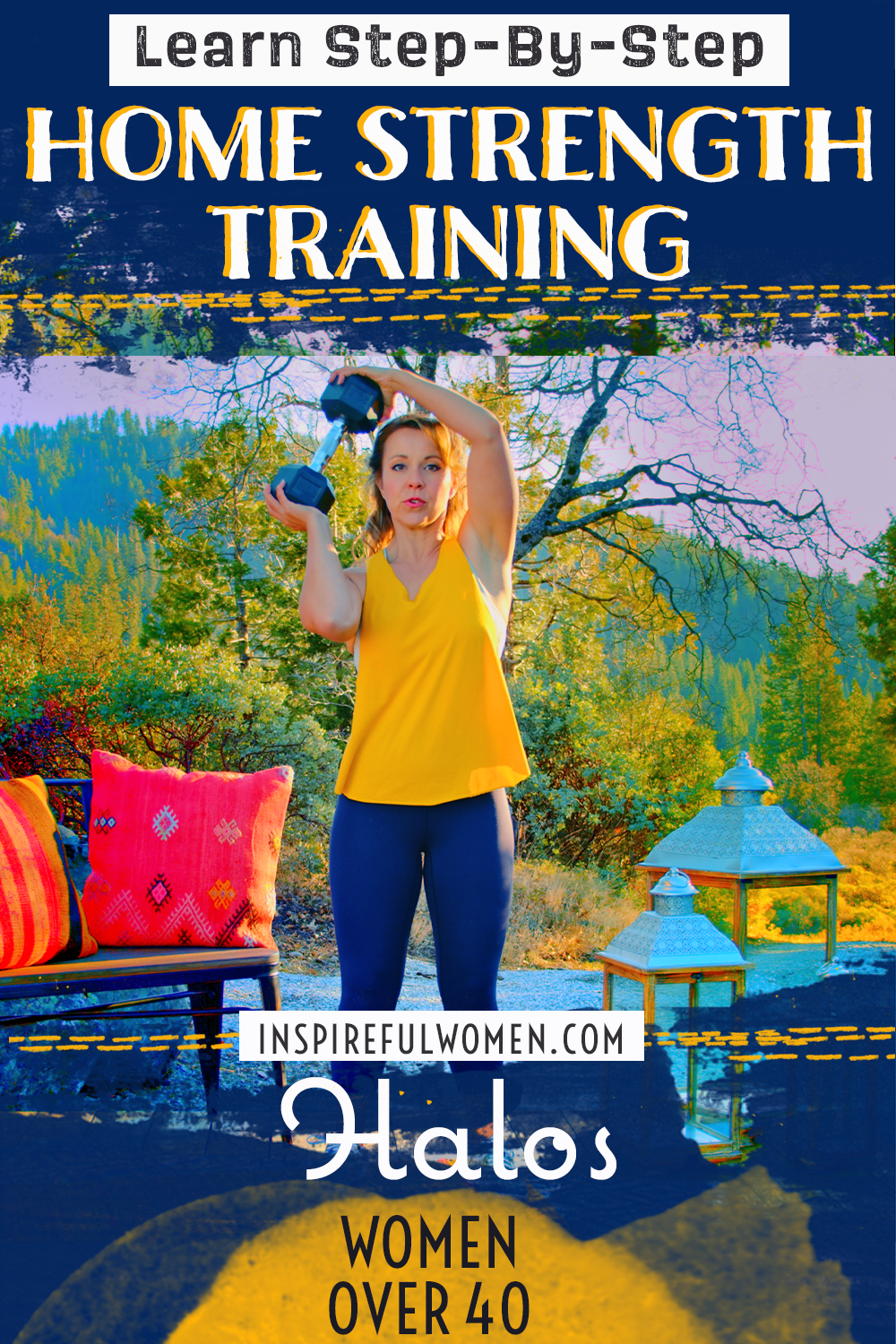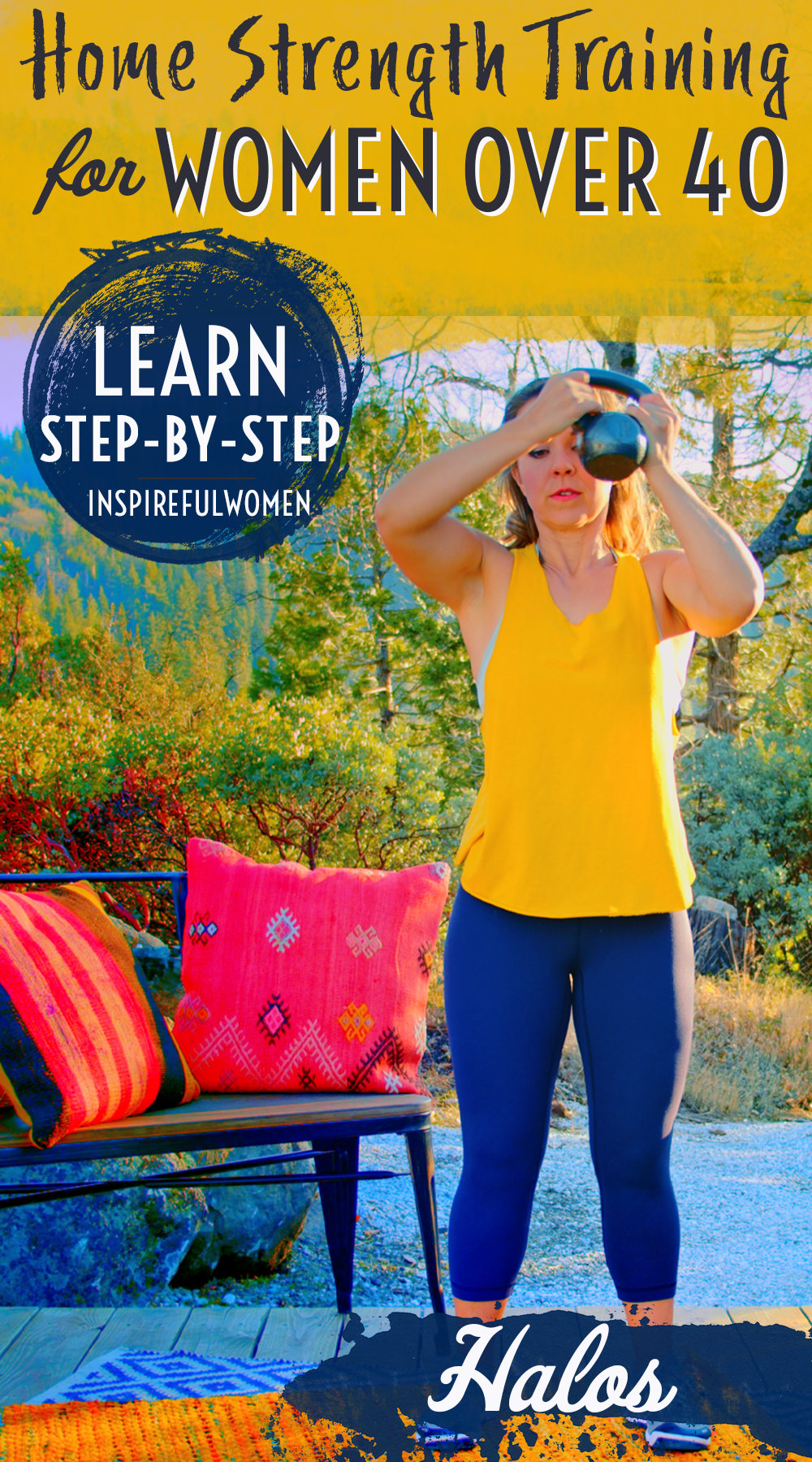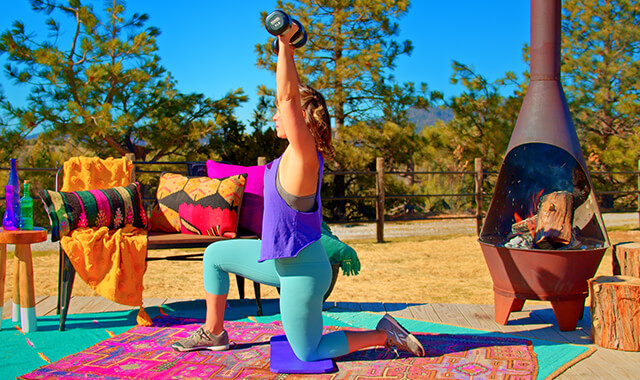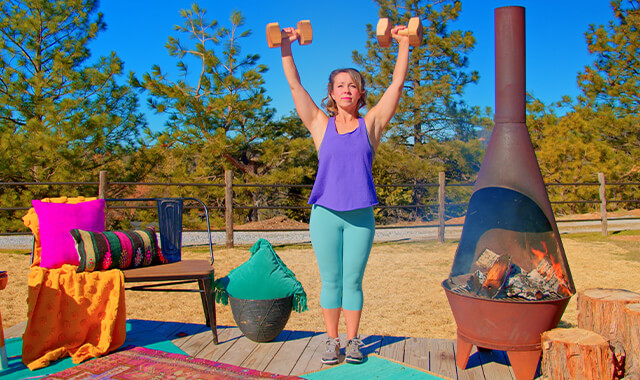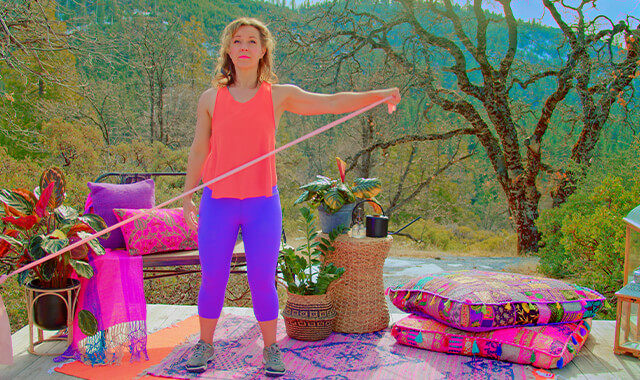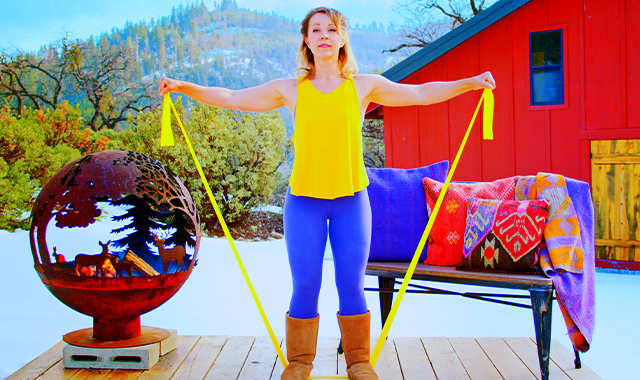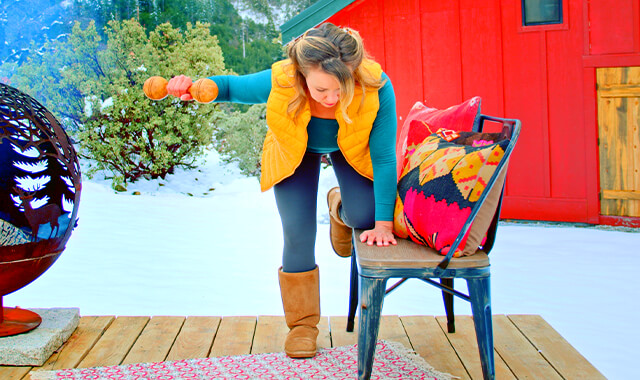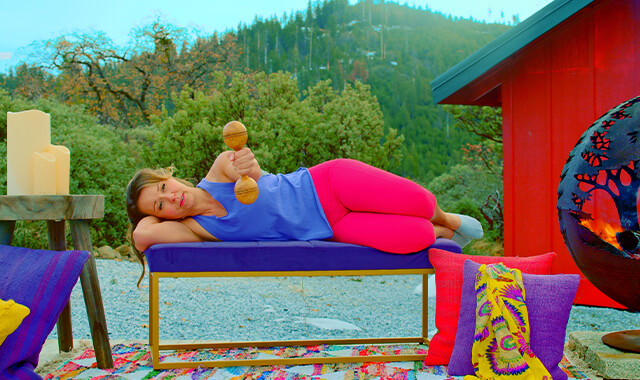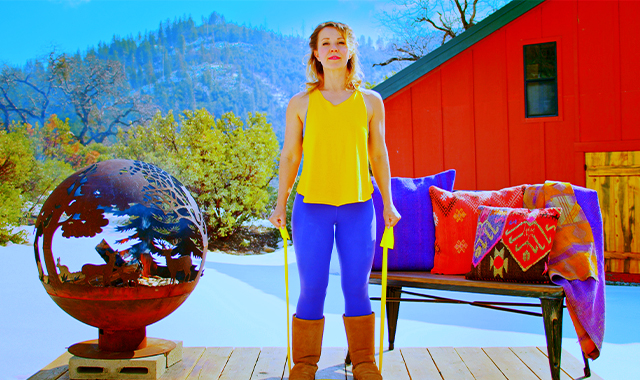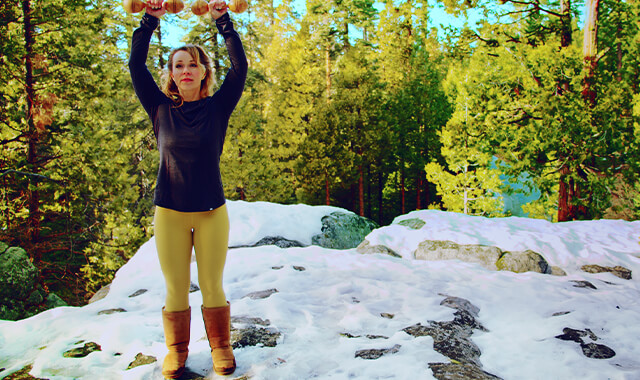Dumbbell Halos
Shoulder exercise
How to Do the Dumbbell Halos Rotator Cuff Shoulder Activation Exercise | In-Depth Guide [VISUAL LEARNERS]
Proper Form, Common Mistakes, & Variations + Easier | Home Resistance Training
WHAT DO YOU WANT TO SEE?
QUICK DEMO
QUICK DEMO
MUSCLES THIS WORKS
MUSCLES
MAIN MUSCLES WORKED IN Dumbbell halos
rotator cuff muscles
This exercises all 4 Rotator Cuff Muscles of the shoulder: the supraspinatus, infraspinatus, teres minor, and subscapularis
OTHER MUSCLES WORKED:
- Scapular Muscles: Trapezius, Levator Scapulae, Rhomboids, Pectorals, Serratus Anterior, Latissimus Dorsi
WHAT WE'RE DOING TODAY
WHAT & WHY
BENEFITS OF TRAINING our rotator cuff muscles
WHAT
WHAT WE'RE DOING TODAY
ALL WE'RE DOING:
We'll be circling our heads with a dumbbell, kettlebell, or mini-band. Like we're trying to prove over and over to everyone that we really are an angel. ;)-
TRAIN STABILITY & MOBILITY OF SHOULDER JOINT
Many of us have heard of the rotator cuff, but I wasn't exactly clear on exactly what it was at one time.
The rotator cuff are four small muscles of the shoulder. These four muscles are responsible for keeping our highly mobile shoulder joint not only mobile so we can move our arms in lots of ways but also stable as well to protect the joint from injury.
The dumbbell or mini-band halos train the smaller muscles of the shoulder joint to move the arm with control through rotational motions. In this exercise, the rotator cuff, and muscles of the shoulder blade and arm will be working together in coordination. Rotator cuff exercises are designed to train the muscles for both stability and mobility of the shoulder joint.
GREAT FOR BOTH WARMUP OR STAND-ALONE EXERCISES
The rotator cuff exercises like the halos can be used
- for a warm-up before upper body weight training
- as stand-alone exercises,
- in between arm strength training to increase blood flow and get the joints moving,
- or as a way to end a workout - giving the muscles just a bit more of a challenge and loosening up the joints.
Rotator cuff muscles are small muscles that need to be able to work at a low level for a long period of time. Think about how much you move your arms. Every time you move them all of the rotator cuff muscles need to work to help control the movement. This is important to think about when you are training the muscles.
USE LESS WEIGHT/RESISTANCE & MORE REPS
The rotator cuff exercises are done with lighter resistance and more repetitions - training the muscles to work at a lower level for a longer period of time. These exercises can be done daily. They are good exercises for when you take a break from sitting and working on a computer or after a long drive.
So in this case, the goal is not to use heavy weights. Just keep it light. These are small muscles!
WHY BOTHER DOING IT?
WHY
WHY DO WE EVEN CARE?
ROTATOR CUFF EXERCISES ARE ALL ABOUT KEEPING HEALTHY SHOULDERS
If you're over 40, chances are you've had some sort of issues with at least one shoulder, and more likely than not, the pain or injury had to do with one of the rotator cuff muscles.
The main reason we have arms is to move the hand to different positions so you can use it.
This means that the arm has to be able to move a lot and once the hand is where you want it to be, the arm is held still. The four rotator cuff muscles that surround the shoulder joint play a big role in making sure the the upper arm bone and shoulder blade work together while we move the arm to prevent injury and long term damage to the joint. Strengthening these muscles with exercises like this one, helps keep the shoulder joints healthy.
HOW ROTATOR CUFF EXERCISES CAN REALLY HELP US 40's AND UP LADIES SPECIFICALLY:
Much of the damage done to our bodies is when we are in our 20-30s, small amounts of damage over the years add up - examples are poor posture, working out with poor form, repetitive job tasks - repetitive overhead lifting, too much sitting (desk jobs), especially when the chair, desk, computer set-up is incorrect and previous injuries - car accidents, falls, sports injuries. The body has an amazing way of compensating by using other muscles, or moving in different ways to accommodate for tight, weak or painful joints and muscles. Many times we are completely unaware of this, but eventually, it catches up.
Wear and tear over time, with the development of compensatory movement is the most common case for people to be in physical therapy, and mostly in people between the ages of 40 and 60. Fortunately, this is an age group that can still make a great difference in our physical abilities if we know what to do and what not to do.
Damage and weakness of the rotator cuff muscles can be caused by normal daily activities such as using a computer, texting, driving, reading, eating, cleaning, all involve using our arms in front of us, frequently with our shoulders rounded forward, slouched posture, and forward head. This position tightens the chest muscles, and pulls the shoulders forward and into internal rotation, decreasing the space where one of the rotator cuff muscles travel through. Over time the joints of the upper back and ribs will become stiffer and the muscles of the back will weaken due to disuse. In the beginning you may not feel any restrictions, pain, or be aware of any weakness.
If you continue down this path and don’t correct your posture, strengthen, and stretch, the joints will become even more restricted and the muscles weaker. The body has an amazing ability to compensate without awareness. You may begin to stand on your tiptoes to reach objects without realizing that your shoulder motion is limited.
As we age we do lose the elasticity of the soft tissues - the tendons and ligaments become stiffer. This makes them more prone to tearing (imagine a new rubber band that can easily be stretched, compared with an older one that may crack because it is not as stretchy). The production of the fluid in the joints can decrease (although it increases with movement). This reinforces the importance of taking time to warm up properly before exercise.
Additionally, disease processes can affect the rotator cuff muscles: for example, cardiovascular disease, diabetes, hypothyroidism all can affect the health of the tissues.
Stretching, strengthening, and correcting posture and movement can improve the health of the rotator cuff muscles, slow age-related changes and help to prevent future injury. With age you will lose muscle mass, beginning at 40. Exercise can prevent or reverse muscle loss - it is possible to gain strength even at 90 years of age. Bone density can decrease (with disease - osteoporosis/osteopenia) which can be slowed/reversed with exercise.
IDEAS FOR WHEN TO DO THESE MOVEMENTS:
PART OF DYNAMIC WARMUP: These are great to do as a part of a dynamic warm-up prior to working out. Warm-up movements increase blood and lymph (part of the immune system) flow, warms the connective tissue (muscle, tendons, ligaments, fascia) to improve their elasticity (will stretch instead of tearing), “wakes up” the muscles that will be worked - brings awareness to the muscles to improve the mind-body connection by actively contracting the muscles.
ON A REST DAY: Muscles get stronger by working them to the point of fatigue, this results in tiny tearing, called microtrauma of the tissue. The message sent to the brain is that the muscles are not strong enough to do the job that the body is trying to do. The response from the brain is to strengthen the muscle in order to improve its capability. Rest days are needed to allow the tissues to heal and grow. Part of the healing process is to remove the wastes and send in nutrients. Gentle movement will accomplish this.
END OF WORKOUT: If your goal is to improve the strength of the muscle it is important to fatigue the muscle. Adding these exercises to the end of a workout is a nice way of making sure that you have included some exercises that specifically address the rotator cuff muscles, in addition to making sure that you have properly fatigued the muscle.
WHEN SHOULDERS ARE FEELING “STICKY” DURING WORKOUT: Motion is Lotion - moving improves the mobility of the joints and soft tissues. “Sticky” areas in movements can be caused by a number of things - poor joint mobility which can be caused by insufficient joint lubrication (synovial fluid), stiff ligaments, or tightness or stiffness of the muscles, tendons, or fascia. Movement can help in all of these cases: increases the synovial fluid in the joints, increases the temperature and therefore the elasticity of the muscles, tendons, and fascia by increasing blood flow.
Fascia is a thin sheet of connective tissue running throughout the body between the muscle and the skin. The fascia allows the skin to be able to glide effortlessly over the muscle (you can feel this by taking your fingers and gently moving the skin over the underlying muscles. Sometimes you get restrictions in the fascia where it no longer glides smoothly with movement (this frequently happens around scars). Tendons run in sheaths of connective tissue and are surrounded by a layer of fluid, sometimes the tendon can get hung up somewhere in the sheath and feel caught or stuck, movement can help to loosen this restriction. By warming up with larger, fluid, movements that combine many directions of motion you “floss” the tendons in the sheath and improve the ability to glide these soft tissues. Leading to freer, unrestricted movement.
HOW FREQUENTLY CAN THESE EXERCISES BE DONE?
Exercises that work the endurance muscles can be done daily. This includes core exercises, balance and stability training. The muscles work at a low level for a long period of time every day. The reason for giving a rest to the larger power muscles is that in order to strengthen those muscles you need to use heavy weights and push them to the point of failure - actually causing small tears in the tissue. The muscle needs a day to make the repairs to the tissues. The endurance muscles are worked at a low level for an extended period of time, the training is more focused on form and muscle re-education as opposed to muscle failure.
EVERYDAY LIFE
EVERYDAY LIFE &
MUSCLE FUNCTION
HOW WE USE OUR rotator cuff MUSCLES IN EVERYDAY LIFE
All four muscles work together to stabilize the arm in the socket both at rest and during all uses of the arm. They support the larger muscles in doing things.
1. SUPRASPINATUS [LIES ABOVE THE SPINE OF THE SCAPULA]
- Lifting and holding the arm out to the side (shoulder abduction)
- Pulling up pants
- Lifting and carrying a car seat at your side.
- Holding the arm in the socket against a downward pull on the arm (assisted by the deltoid)
- Lifting and carrying heavy items
2. INFRASPINATUS [LIES BELOW THE SPINE OF THE SCAPULA] AND TERES MINOR
- Rotates the upper arm outward - the soft underside turns outward (external rotation)
-
- Outstretched arm
- Turning the arm over to receive change
- Turning arms outward to carry a large tray or getting a roasting pan out of the oven
3. SUBSCAPULARIS [LIES ON THE UNDERSIDE OF THE SHOULDER BLADE - THE SIDE BY THE RIBCAGE]
- Rotates the upper arm inwards (internal rotation)
- Keeping the forearm still while pouring out a jug of water
STARTING POINTERS
Starting Pointers
Halos can be used to work on the general mobility of the shoulder joint and the upper back (thoracic spine), making them an option for warming up the joints and the smaller muscles of the shoulder before strength training. This exercise can be included as part of a shoulder workout series to work all of the upper back and arms - for example: Bus drivers, Banded pull aparts, Figure 8s. It can also be used as a stand-alone exercise with a heavier weight to target the deltoid and all the muscles of the shoulders and arms.
Halos are done by circling a weight around the crown of your head. The movement works the muscles that move the shoulder blade and control the movement of the upper arm in the shoulder socket.
This movement trains all four the rotator cuff muscles, the muscles that move and stabilize the shoulder blade, along with the deltoid, and even the low back and abdominals. This is a great way to train the muscles to work together to hold the torso still as they control the movement of two of the parts of the shoulder joints - the shoulder blade and the upper arm bone.
HOW TO FEEL WHAT MUSCLE IS WORKING
How to Feel What Muscle is Working
These are small, deep muscles that cross the shoulder joint. The best way to feel them working is to try to relax the larger muscles of the arm. Bend the elbow to 90 degrees and slowly the upper arm bone in and out - your forearm and hand moving in an arc-like a windshield wiper. You may not be able to feel the muscles working but you should be able to feel the upper arm bone rotating.
HOW TO DO THE EXERCISE
LOOKS
HOW Dumbbell HALOS SHAPE OUR BODY
Improved upright posture, decreases rounded shoulder posture. Tones the shoulders and arms. The supraspinatus and infraspinatus can provide shape to your upper back and upper shoulder (under the upper trap).
PROPER FORM
PROPER FORM: Dumbbell HALOS
EQUIPMENT, SETS & REPS
EQUIPMENT
2-3 lbs dumbbells, kettlebell, weighted ball or household object - can, jar, bottles, or any object that can be easily held with both hands
SUGGESTED STARTING WEIGHT FOR WOMEN:
1 - 3 lbs
SETS & REPS:
2 sets of 10-15, or timing the exercise works well - 2 -3 sets of 15-30 seconds
PACE:
Slow, controlled
BODY POSITION
BODY POSITION FOR Dumbbell HALOS
FEET: Feet shoulder width apart, toes forward
BODY STANCE: Standing tall. Sternum lifted, neutral spine, knees slightly bent
HAND/GRIP: Hold one end of the dumbbell in each hand, the dumbbell handle is parallel to the floor
ARM: Upper arms by your sides (from shoulder to elbow), elbows bent, hands holding dumbbell in front of chest
NECK: Neutral/relaxed
HOW TO DO
HOW TO DO DUMBBELL HALOS
CUE: Keep space between your shoulders and your earlobes. While the wrists are moving, keep in mind the focus is really movement at the shoulder so make sure a lot of the circling is being achieved by the shoulder joint and not just the wrists bending a lot.
Lift the dumbbell up with both arms until the dumbbell is in front of the forehead.
Begin to circle the dumbbell around your head - as if you were drawing a circle all the way around your head (like a halo). Your upper arms will stay up and out to the front throughout the reps, they don’t return to your sides.
If you circle clockwise around your head:
The left upper arm moves up with the elbow bent, the forearm moves over the top of the head and the upper arm is close to your ear.
The right arm moves down.
The left-arm moves the back behind the right side of the head and the right arm follows.
As the weight passes the back of the head, the left arm begins to lower and the right arm moves up.
Continue for the desired number of reps and then switch directions.
DON’T FORGET TO REVERSE THE DIRECTION! I FORGET THIS EASILY.
HOW TO SAFELY GET OUT OF THE EXERCISE
Bring the arms down to neutral. Squat down to place weight on the floor.


COMMON MISTAKES
COMMON MISTAKES
WHAT TO AVOID WITH Dumbbell HALOS
KEY TIP:
Guess what? Good news! Many avoids are the same for most movements. Once you learn the basics, there's really only a few extra avoids for each individual movement.
1. Avoid Using Neck Muscles
AVOID: Avoid tightening the neck muscles.
WHY NOT?
- Will interfere with the proper movement of the shoulder joint
- This can lead to neck or shoulder strain, injury or damage over time.
- You may feel neck discomfort, find that you are pressing down with your head, or gripping with your neck muscles.
- This will defeat the purpose of the exercise, the goal is to move the upper arm using the small muscles.
2. Avoid Shoulders Riding Up During the Movement
AVOID: Avoid moving your shoulders up and down as the arm moves.
WHY NOT?
- Will interfere with the proper movement of the shoulder joint which can result in soft tissue or joint irritation, injury, or damage over time.
- Moving the shoulder up and down will not work rotator cuff muscles to move the arms.
WHAT TO DO:
- The shoulder blade may rotate up or down but avoid lifting the shoulders up - press them down.
- Maintain good posture with the sternum lifted, space between your earlobe and the top of the shoulder.
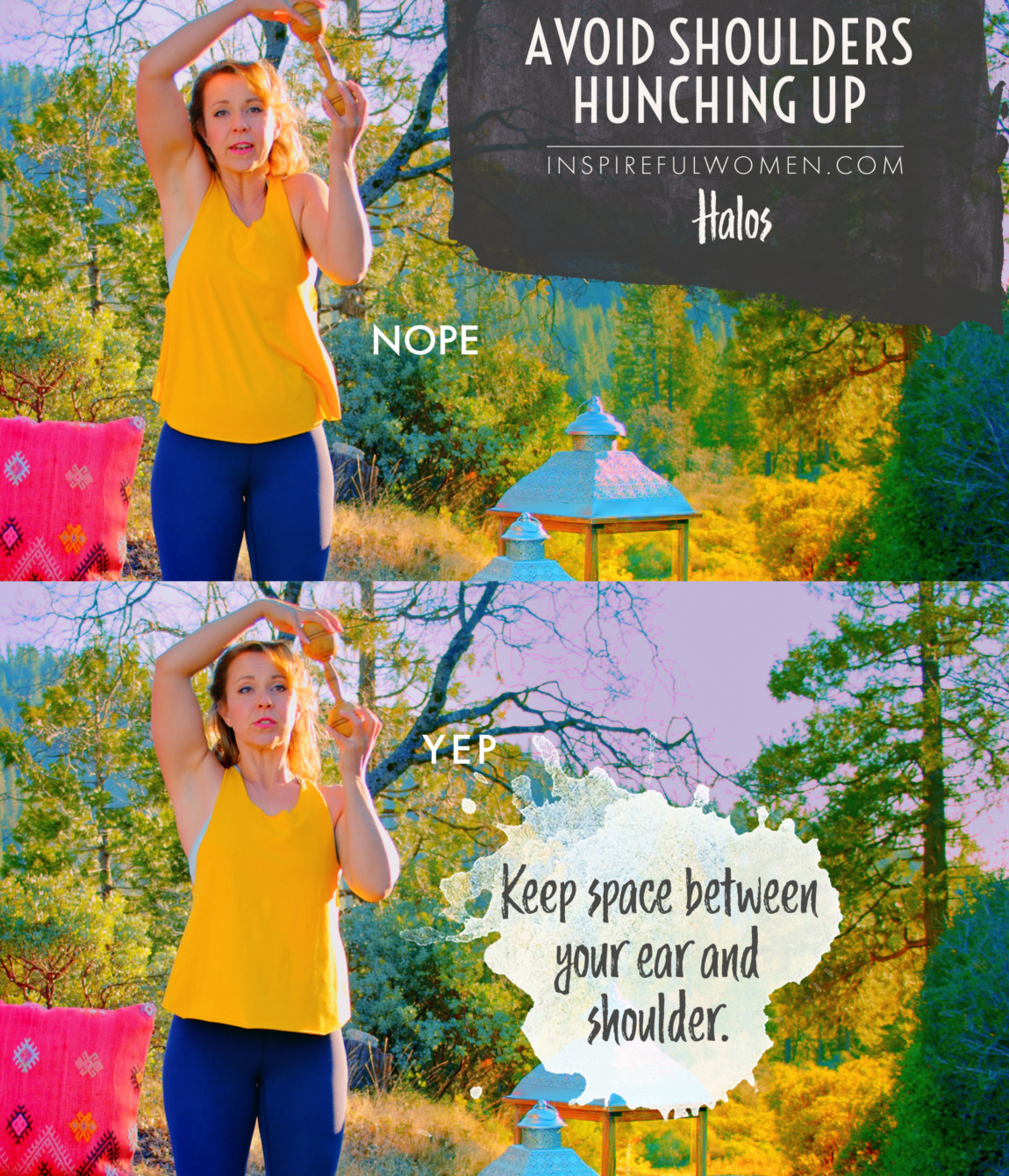
3. Avoid Moving Through Pain in Wrists
AVOID: Avoid moving the writst through pain.
WHY NOT?
- Working through pain may lead to injury. There are lots of tiny bones and ligaments in the wrist that can get irritated rather easily.
WHAT TO DO:
- Use a lighter weight that doesn't cause pain or not too many reps.
4. Avoid Hands Falling Uncontrolled
AVOID: Don't let the arms drop down in front of you on each rep.
WHAT TO DO:
- The idea is to keep the arms and hands elevated around your head, creating that rotational component in your shoulder socket.
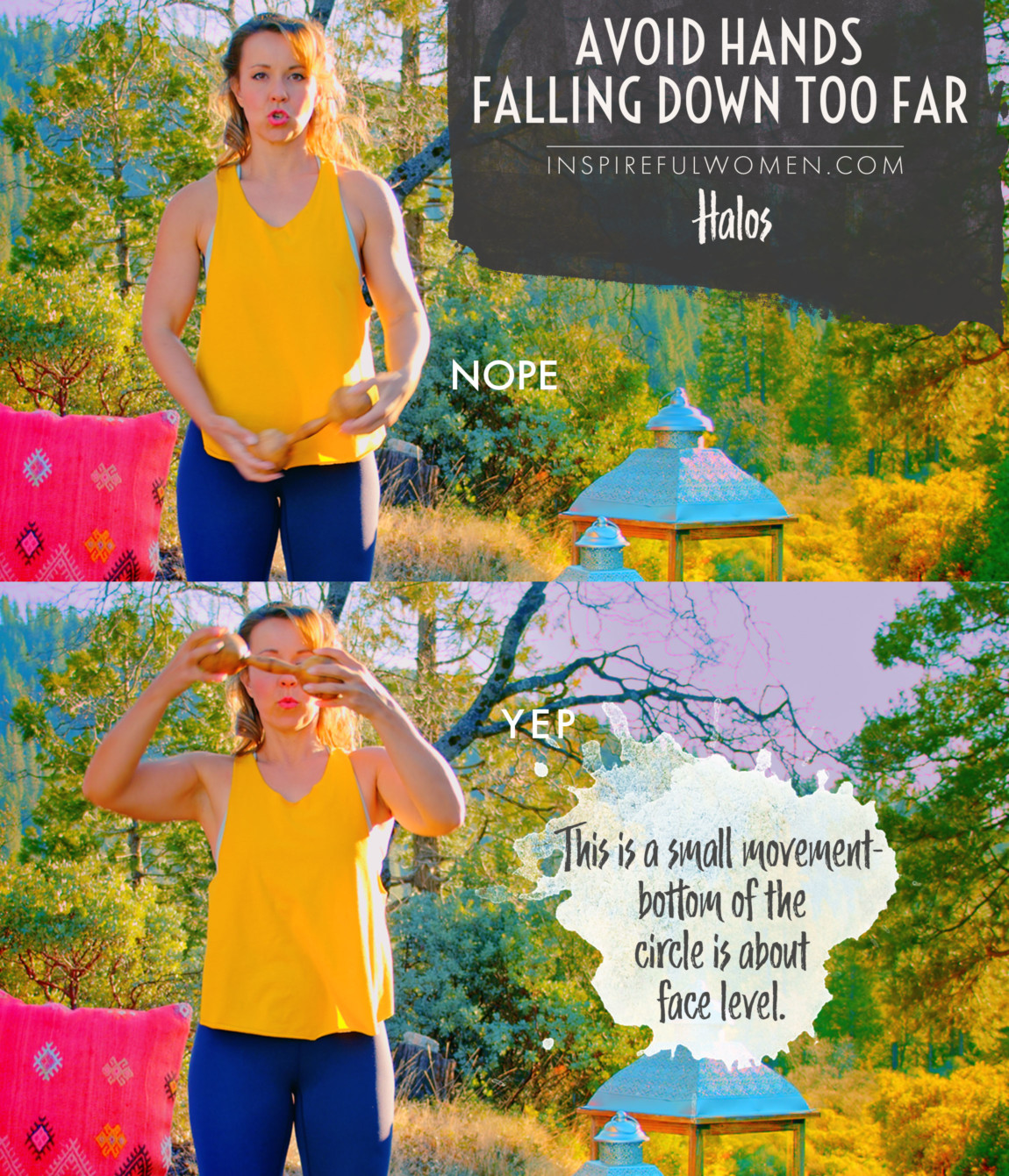
5. Avoid Moving Through The Torso
AVOID: Avoid moving the torso.
WHY NOT?
- The goal is to target the small muscles of the shoulder joint - moving the spine as opposed to the arm in the socket will use the wrong muscles.
WHAT TO DO:
- Keep your torso nice and still and focus on the movement coming from the shoulder- your upper arm bones is moving around inside the shoulder blade cavity.
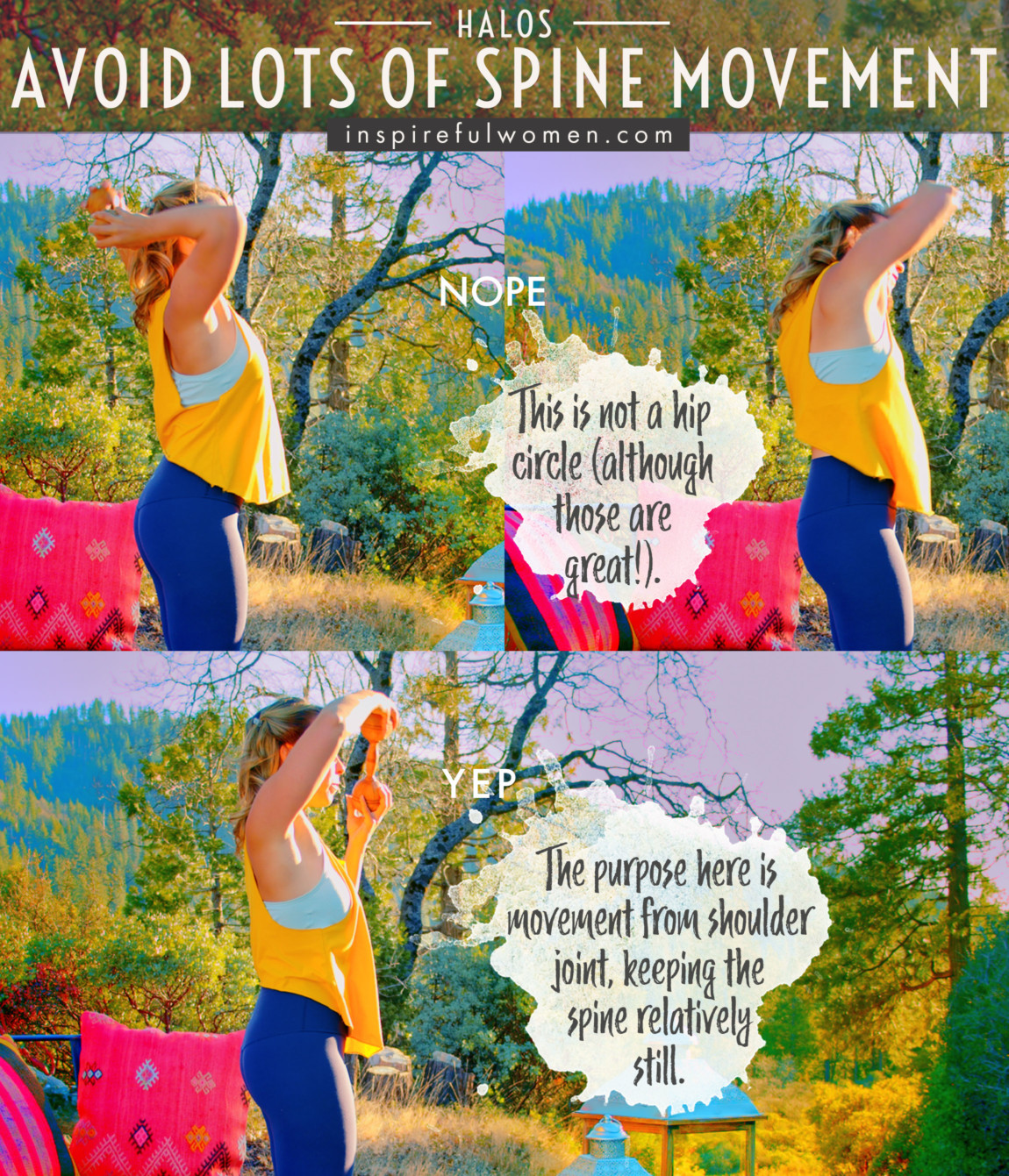
6. Avoid Circles Too Big
AVOID: Avoid making the circles too big.
WHY NOT?
- Making circles that are too big may result in moving through the spine more, and using the low back muscles more
WHAT TO DO:
- The forearm should barely graze the top of the head as it circles around.
- The goal of the exercise is to increase the movement of the shoulder joint and work the small muscles of the shoulders.
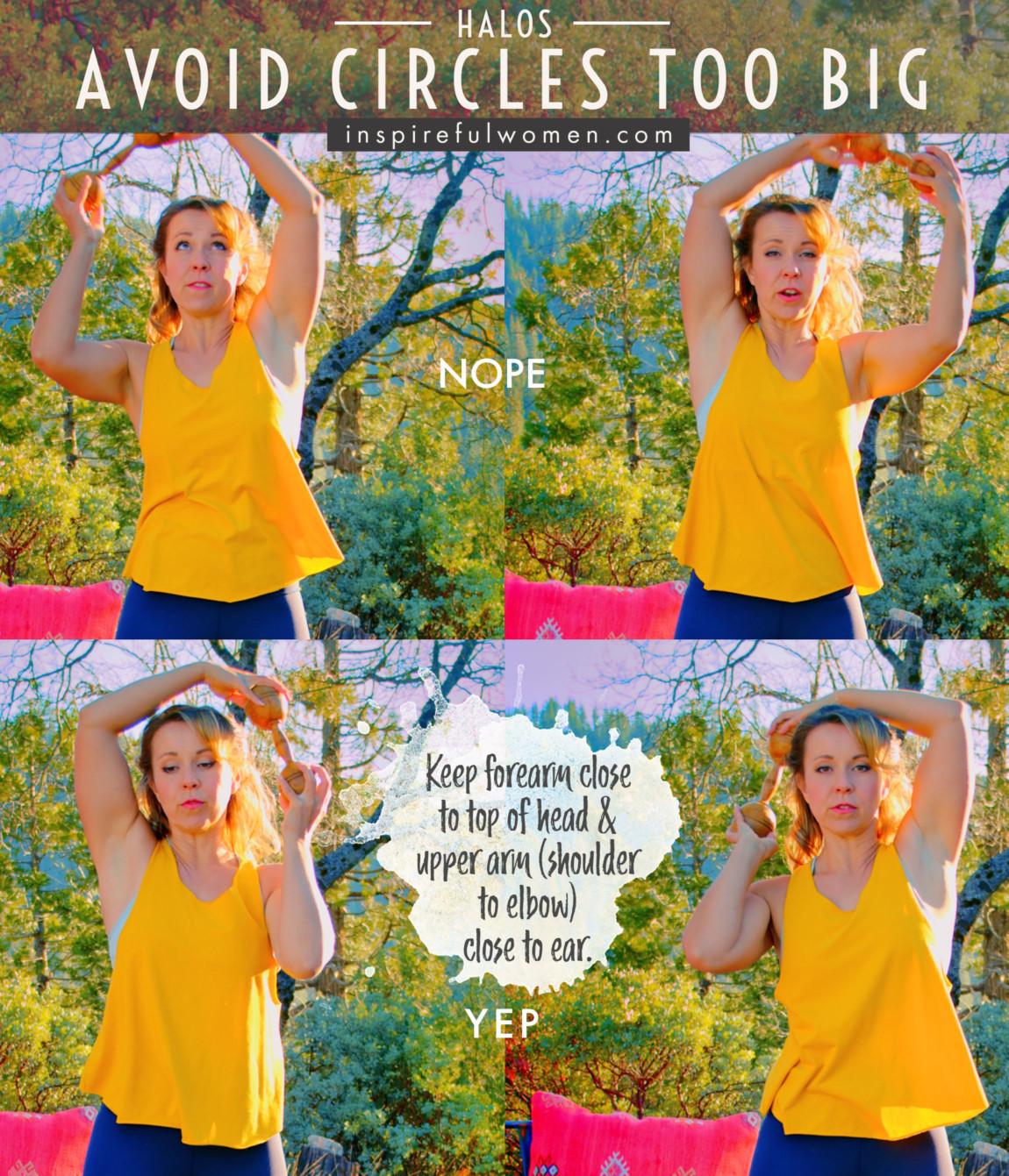
7. Avoid Pushing Neck Forward or Back
AVOID: Avoid moving your head forward as opposed to moving the arms back.
WHY NOT?
- As the weight is circled behind your head, there can be a tendency to move your head forward as opposed to moving the arms back.
- This can result in muscle strain or joint irritation of the neck.
WHAT TO DO:
- Keep your neck neutral and relaxed.
- Slow the motion down and concentrate on your form.
- It may be necessary to use a lighter/smaller weight or change your movement pattern.
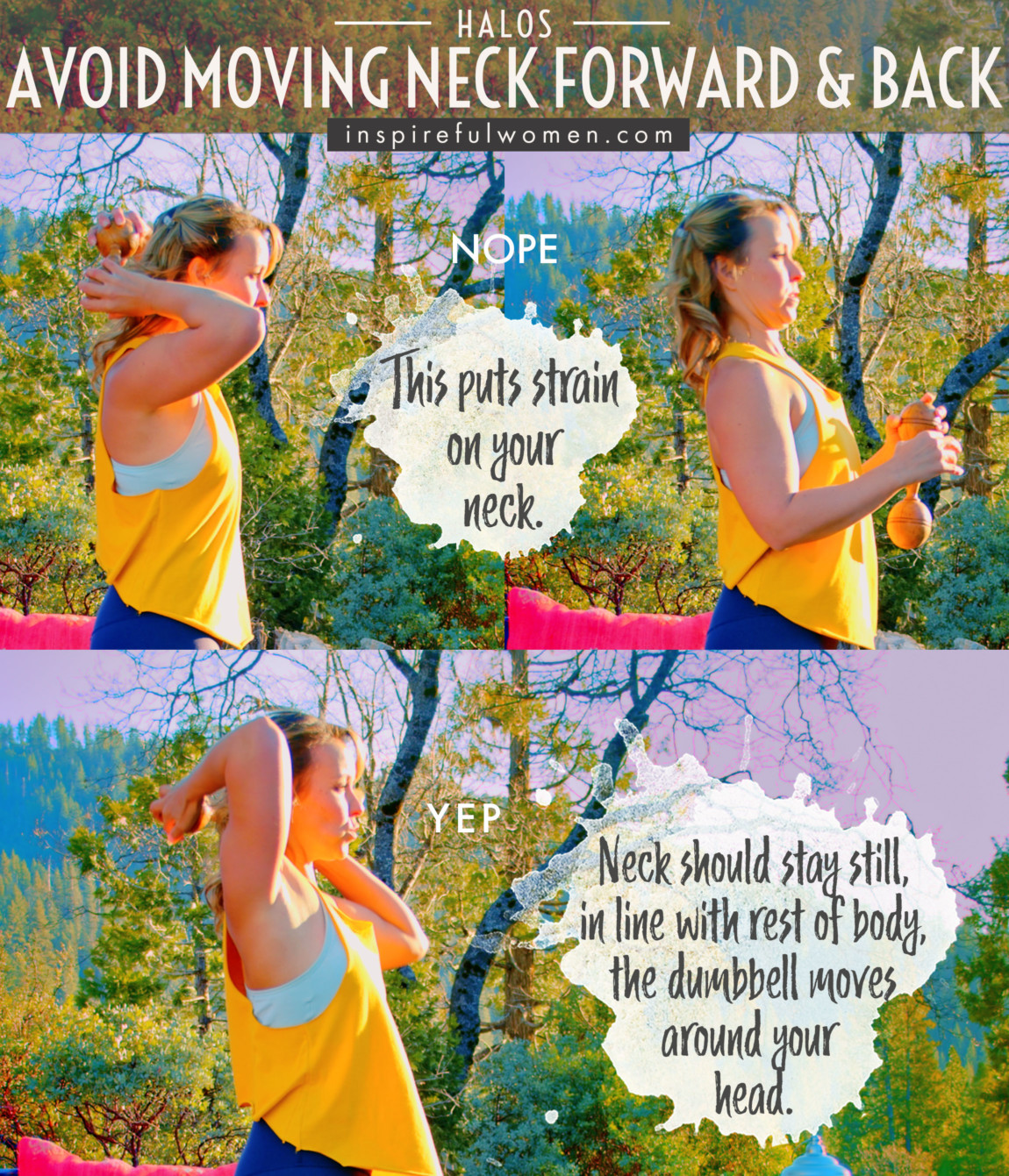
VARIATIONS
VARIATIONS
VARIATIONS OF HALOS
Kettlebell Halos Handle Grip
Kettlebell halos handle grip
I personally find this to be the most comfortable way to do this movement, but not all of us have kettlebells.
Handle grip - Hold the kettlebell in front of the chest. Hold one side of the handle with each hand. Flip the KB over so the bottom is up.
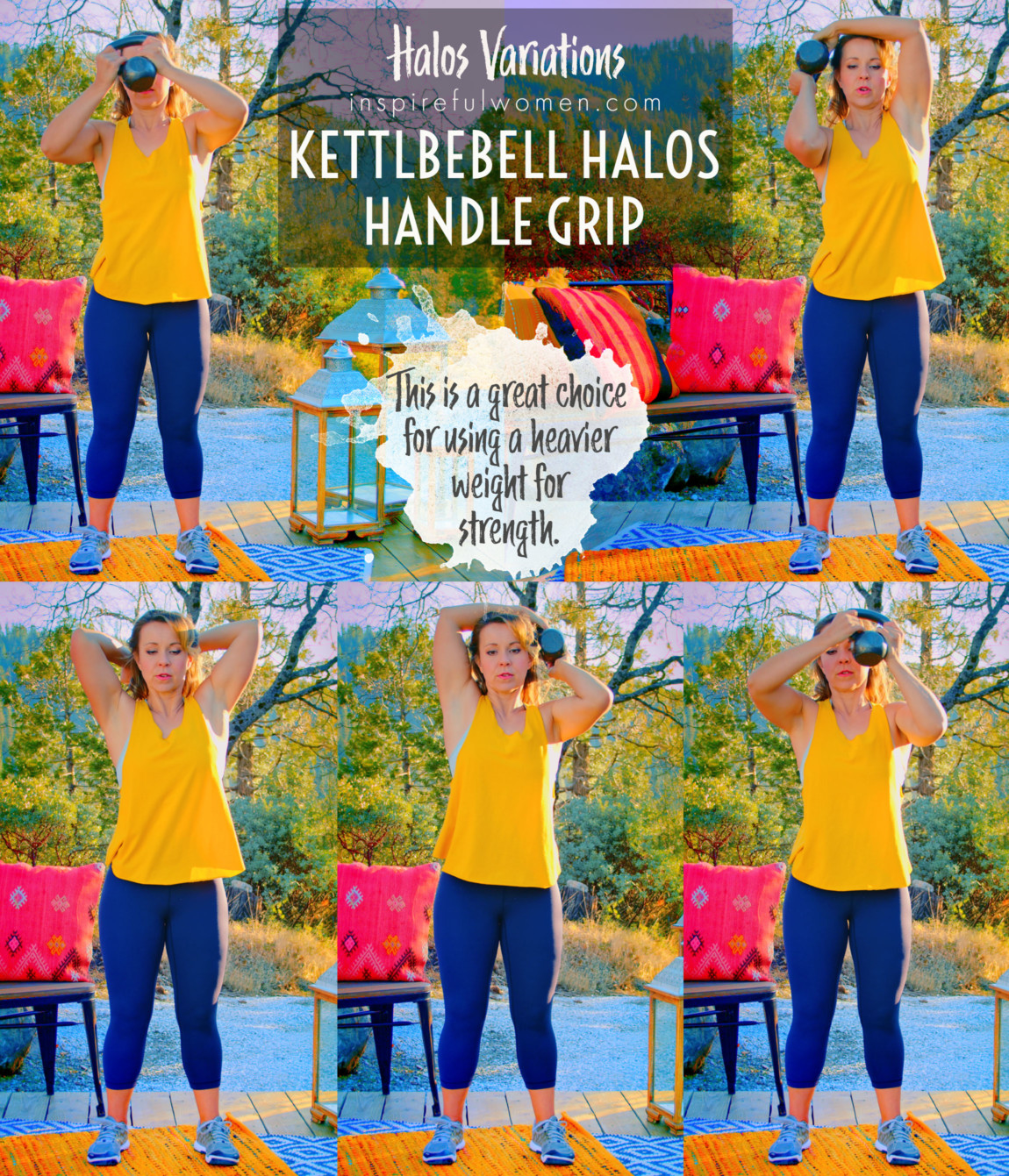

Kettlebell Halos Bottoms Up Grip
Kettlebell Halos Bottoms Up Grip
Bottom grip. Hold the bottom in both hands. Lift up over head.
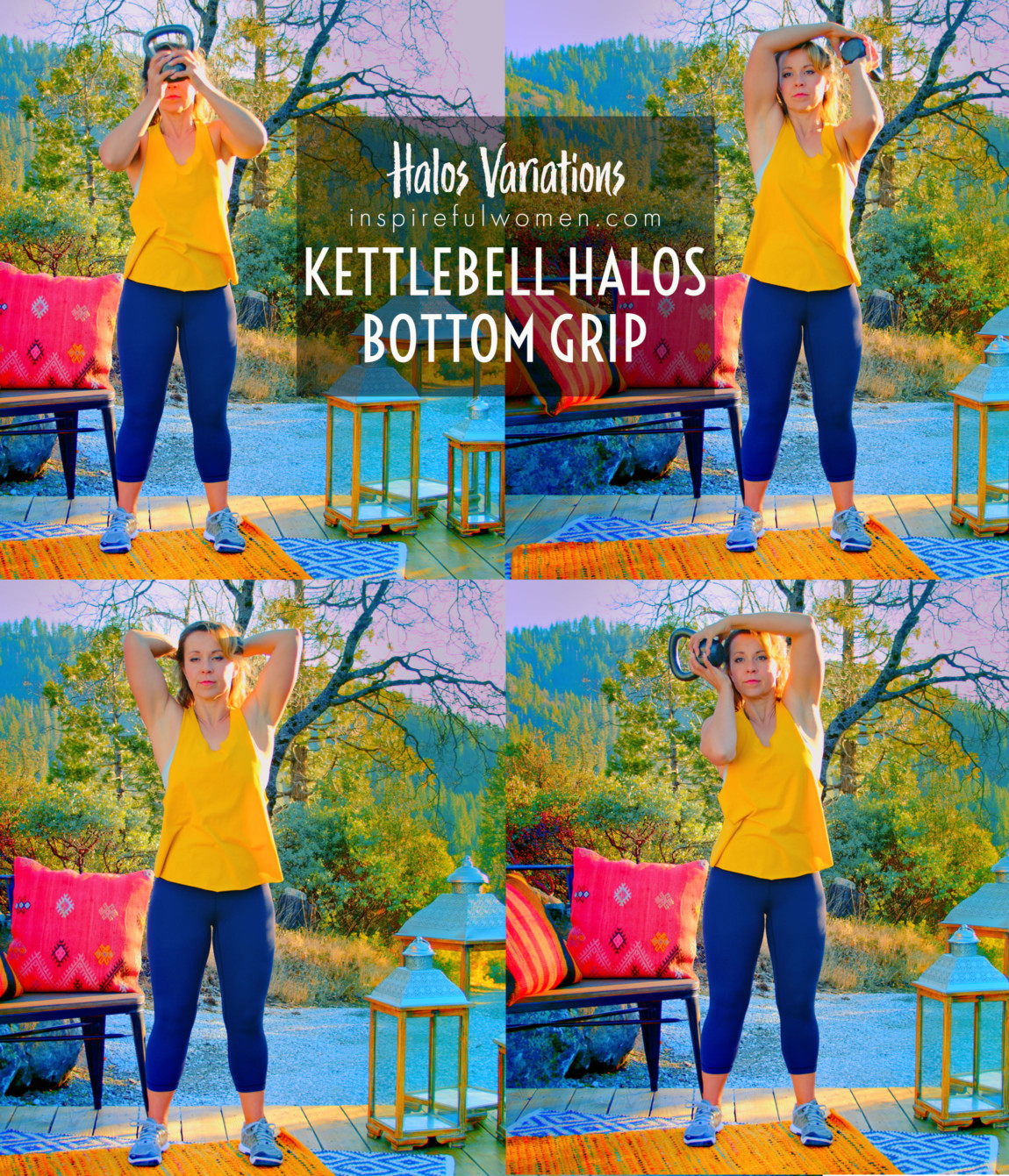
Each rep switch directions
Reverse Direction After Each Rep
Complete a circle in one direction, reverse and complete a circle in the other direction - repeat alternating directions after each rep. This will enhance the training of the rotator cuff muscles by challenging their ability to coordinate the timing of their activity. This is good for sports training when the movement is unpredictable and the brain has to respond quickly to sudden changes.

Heavy Weight Strength Delt Focus
Heavy Weight for Strength
This is particular rotator cuff exercise where you actually can do more from a strength perspective, not just for mobility. When using a heavier weight, the deltoid muscle and other upper back muscles will get more involved to achieve the movement. So this is just another way to do the exercise with slightly different goal and focus.
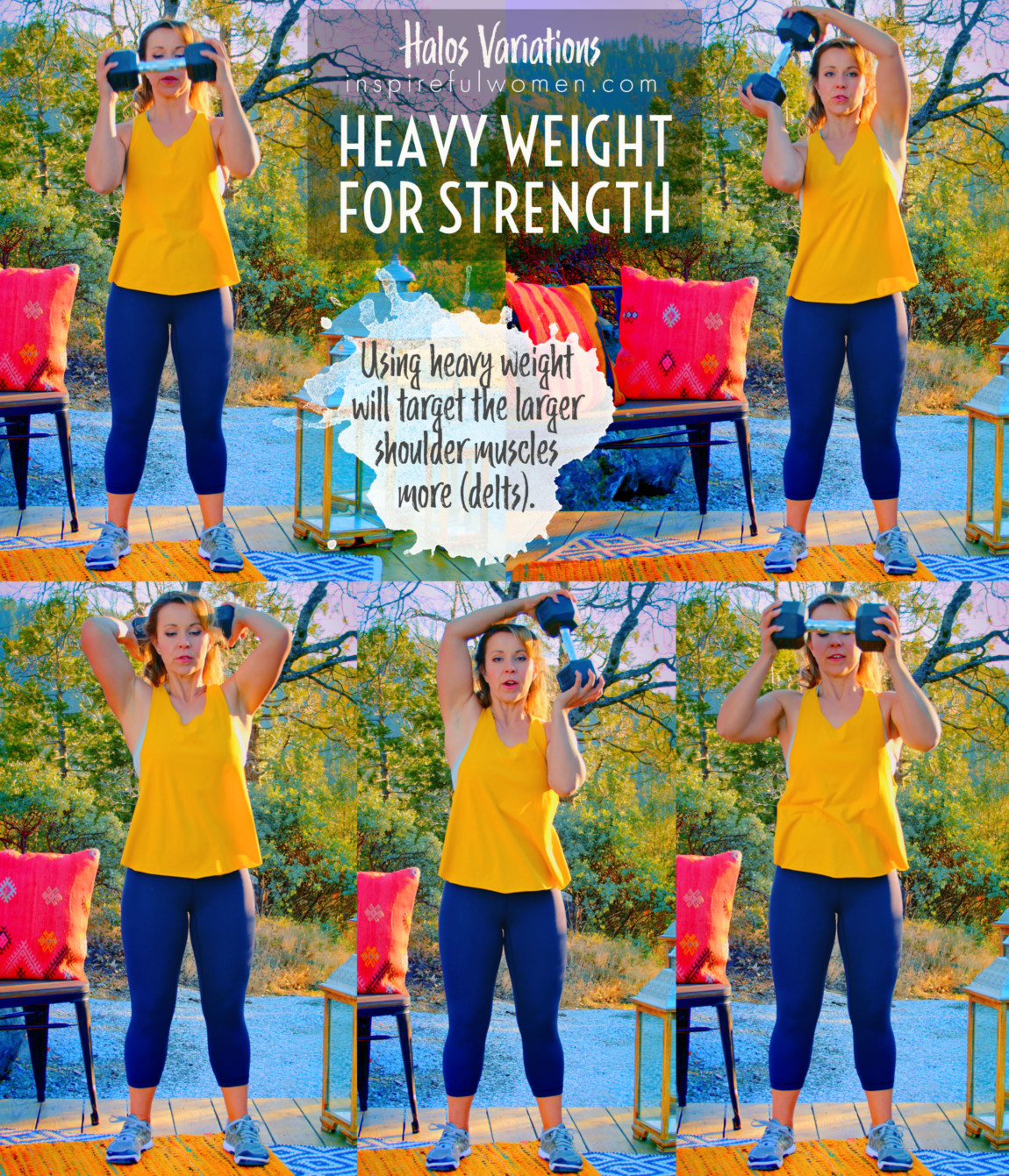

Halos With Weighted or Unweighted Ball
Halos with Ball
Hold a small ball (6 - 10 inch diameter) with both hands - fingers spread palms on ball.
Avoid squeezing in on the ball. Squeezing in on the ball will activate the muscles of the chest and upper arm - the goal of this exercise is to train the smaller muscles of the shoulder joint. Gripping with the larger, stronger muscles can interfere with the muscle activity of the smaller muscles.
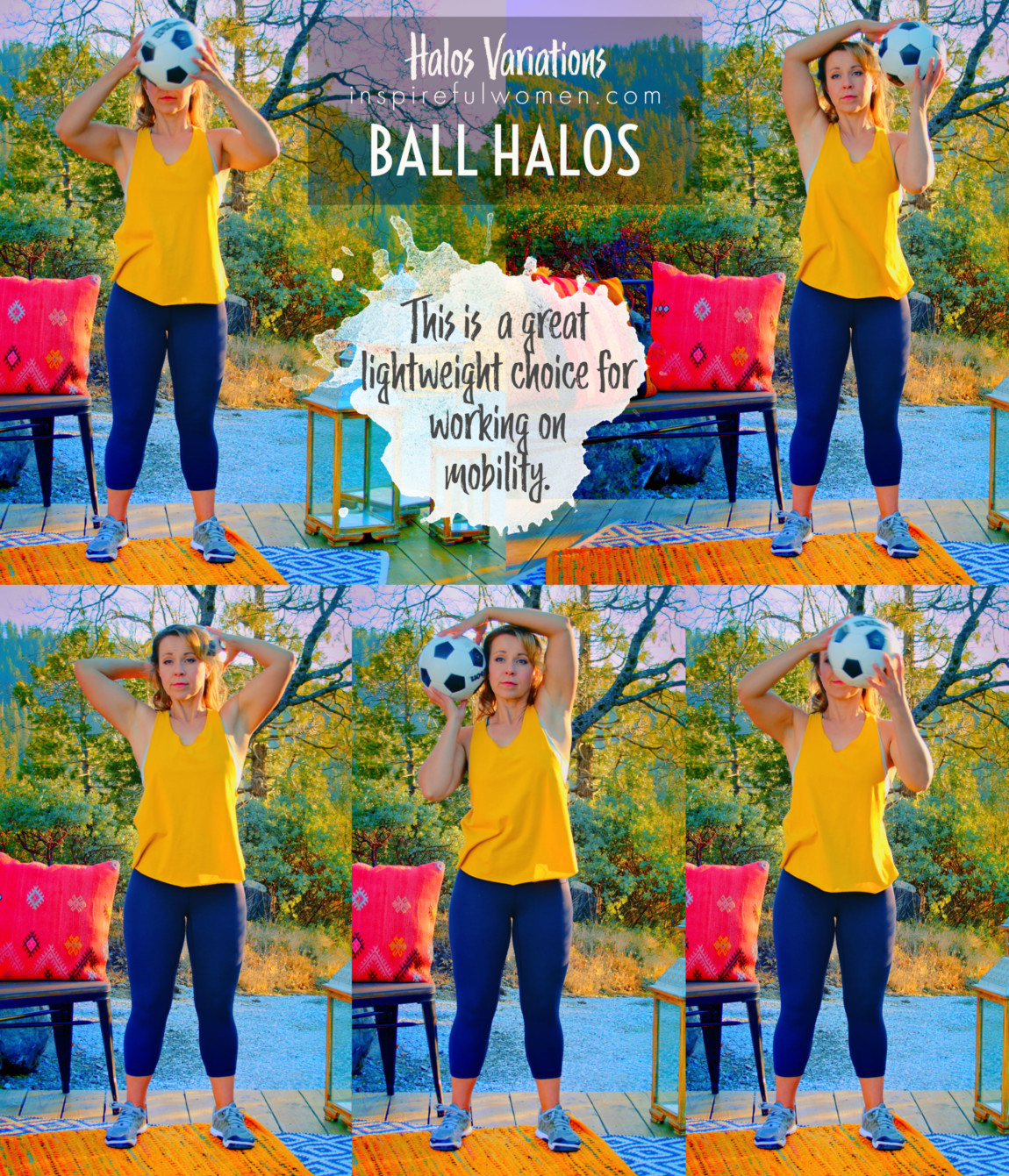
Mini band halos
Mini Band Halos Dynamic Stretch Warmup Focus
Use at the very beginning of a warmup with hands inside a mini band. Push out against the band to hold the band under a slight amount of tension.
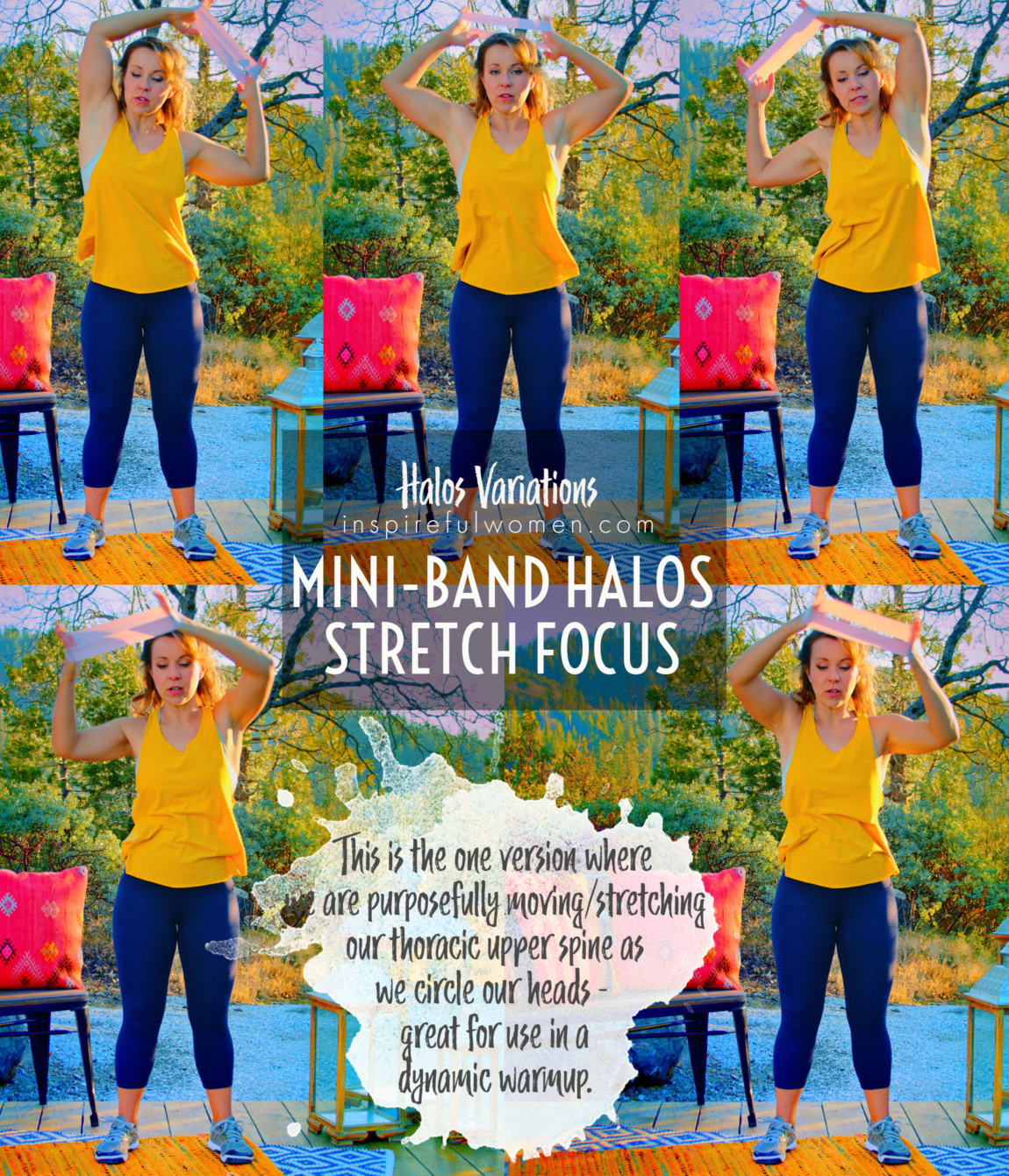
MAKE IT EASIER
EASIER
MAKE THE Dumbbell HALOS MORE DOABLE
Circle Top Of Head only
Circle top of head only
Hold one weight by the handle and circle over the top of the head. Grab the handle of the dumbbell with both hands. LIft weight over head and draw small circles over the top of the head. As you warm up you can slowly increase the size of the circle. This allows you to work on increasing your range of movement.
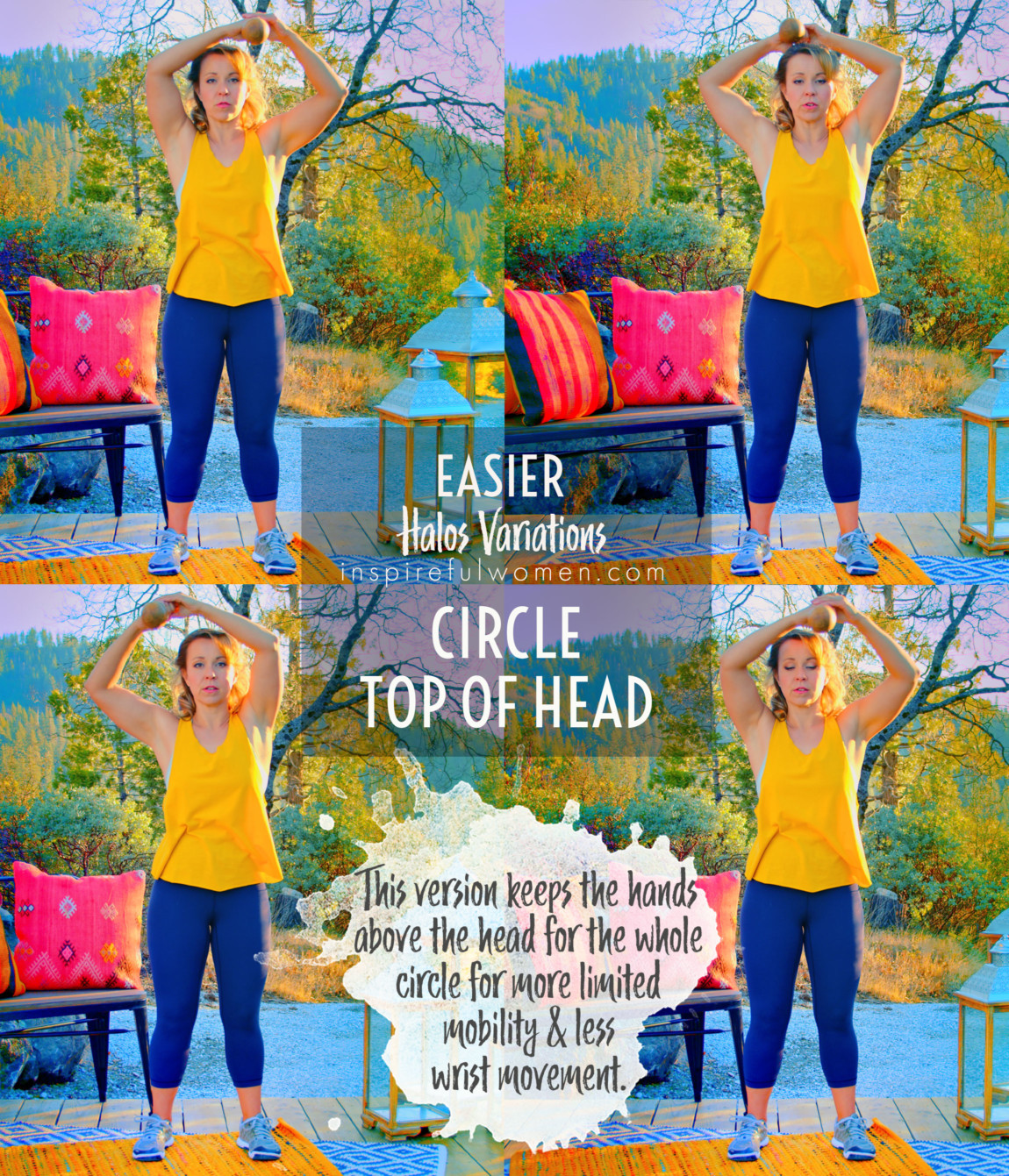
Circle Top Of Head single Hand
Circle Top Of Head single Hand
You can do the same thing but with just one hand on the dumbbell at a time- this is a good choice if you are currently struggling to have the mobility to have both hands on the weight and circle your head without your spine and upper body moving too much, and it's also good if you struggle with wrist pain as you can keep your wrist in a more neutral position.

SCIENCY STUFF
SCIENCY STUFF
SPIFFILICIOUS FACTS ABOUT MUSCLES & MOVES
Halos work the muscles that move the shoulder blade and control the movement of the upper arm in the shoulder socket. This movement trains all four the rotator cuff muscles (supraspinatus, infraspinatus, teres minor, and subscapularis), the muscles that move and stabilize the shoulder blade (pectoralis major and minor, trapezius, levator, rhomboids, serratus anterior, latissimus dorsi), along with the deltoids, low back and abdominals to stabilize in an upright position as the weight circles the head.
The shoulder joint is designed to move, because of this design it is also an unstable joint. The shoulder region is made up of three bones - the collar bone (clavicle), the shoulder blade (scapula), and the upper arm bone (humerus). These three bones are connected with ligaments to form three joints: the acromioclavicular joint (AC), sternoclavicular joint (SC), and the glenohumeral joint (GH).
The largest of these joints is the joint formed between the upper arm bone and the shoulder blade (GH or glenohumeral joint). This is a ball and socket joint, the joint is stabilized by ligaments and a labrum (a ring of cartilage that acts somewhat like a suction cup to hold the upper arm bone in the socket. The small movements of the joint are controlled by the rotator cuff muscles and the muscles that move the shoulder blade. The rotator cuff muscles work together to keep the “ball” portion of the joint centered in the “socket”. The socket is a small shallow cup shaped surface that is part of the shoulder blade. The position of the socket is controlled by the muscles of the shoulder blade. As the arm reaches up, the muscles that move the shoulder blade rotate the shoulder blade so that the socket is angled upward.
Halos involve rotation of the upper arm bone in combination with movement of the shoulder blade as the arm reaches up overhead. This is a great way to train the muscles to work together to coordinate the movement of the two parts of the shoulder joint - the shoulder blade and the upper arm bone.
Halos help to mobilize the wrist joints - this is a good warm up for getting all of the little joints of the wrist loose and working the muscles of the forearm. There are three primary joints [the wrist is actually made up of 8 very small carpal bones, with many, many ligaments connecting them all, and tiny joints where they are joined, in addition to the two bones of the forearm], and many muscles that cross the wrist joint that are used during movement of the hands. Moving the wrists warms up the muscles, tendons and ligaments before more strenuous exercise. Movement increases blood and lymph flow, and mobilizes the fascia to help to prevent injury to the joints, ligaments and tendons that cross the wrist joint. When the tissues are warm they are able to stretch without tearing, and when the joints move they are lubricated to improve their ability to glide as they move, therefore better movement with less irritation and rubbing. Moving the wrists to warm up the two joint muscles of the forearm (cross the elbow and the wrist), can prevent lateral and medial epicondylitis, and improve wrist flexion and extension (improved joint mobility of the wrist) in order to prevent osteoarthritis and carpal tunnel syndrome.
Why Thoracic Spine Mobility is Great:
In general we are much more sedentary than we were designed to be. We spend far too much time sitting at a desk, computer, driving, working just in front of us, even sleeping with a flexed spine. And less time reaching, turning, twisting, climbing.
Motion is lotion: the joints, nerves, discs, and fascia need movement to flush out the wastes and help bring in the nutrients.
Use it or lose it: if we don't move out joints and fascia tend to get stiff. All of the ribs attach to the thoracic spine. The ribs move when we breathe and move our arms. If you do not move all of these little joints they will become stiffer and you will begin to have limited shoulder mobility. Stiff ribs can affect deep breathing.
With all of the sitting that we do, we have a tendency to become stooped with age. Working the upper back into extension or neutral helps to reverse that.
ALLLL MUSCLES & WHEN
ALL MUSCLES WORKING & WHEN DURING Dumbbell HALOS
Muscles of the torso (levator scapulae, trapezius, rhomboids, serratus anterior, pectoralis, latissimus dorsi, teres major, abdominals) work to hold the spine in an upright position and in neutral alignment, also work to move the shoulder blade (to position the glenoid fossa - or socket/cup of the joint) as the weight is moved around the head.
The movement is circling a weight around the head - all of the muscles listed above work together making subtle changes in well-timed muscle activation with a combination of concentric, isometric, and eccentric contractions. The exact pattern of muscle activation is dependent on the size of the circle, and the amount of weight used.
One arm moves out towards abduction (lateral deltoid) and external rotation (infraspinatus, teres minor, rear deltoid). As the other arm moves down and towards adduction and internal rotation (anterior deltoid, subscapularis, pectoralis, biceps). The four rotator cuff muscles will be working throughout the exercise to keep the head of the humerus centered in the socket of the shoulder joint. The biceps and triceps will help to stabilize the joint as the arms move in a circle during the exercise. The triceps will be more active if the elbow straightens a bit as it passes behind the head (to clear the head).
The muscles of the arms work to stabilize and move the elbow joints and control the movement of the arm as it circles the head. The forearm muscles will work to move the wrists as the arms change positions and keep the wrists stable.
PIN IT FOR LATER!
